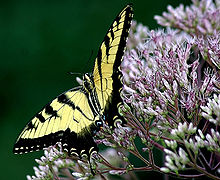
Cirsium palustre, the marsh thistle or European swamp thistle, is a herbaceous biennial flowering plant in the family Asteraceae.

Ageratina altissima, also known as white snakeroot, richweed, or white sanicle, is a poisonous perennial herb in the family Asteraceae, native to eastern and central North America. An older binomial name for this species is Eupatorium rugosum, but the genus Eupatorium has undergone taxonomic revision by botanists, and some species once included in it have been moved to other genera.

Eupatorium is a genus of flowering plants in the family Asteraceae, containing from 36 to 60 species depending on the classification system. Most are herbaceous perennials growing to 0.5–3 m (1.6–9.8 ft) tall. A few are shrubs. The genus is native to temperate regions of the Northern Hemisphere. Most are commonly called bonesets, thoroughworts or snakeroots in North America. The genus is named for Mithridates Eupator, king of Pontus.

Eupatorium capillifolium, or dogfennel, is a North American perennial herbaceous plant in the family Asteraceae, native to the eastern and south-central United States. It is generally between 50 cm and 2 meters tall with several stems that fork from a substantial base. The stems and base are covered in leaves so dissected that they resemble branching green threads coming out of the stem in fractal patterns. When crushed, the leaves and flowers smell rather unpleasant.

Eupatorium cannabinum, commonly known as hemp-agrimony, or holy rope, is a herbaceous plant in the family Asteraceae. It is a robust perennial native to Europe, NW. Africa, Turkey, Syria, Iran, Iraq, Jordan, the Caucasus and Central Asia. It is cultivated as an ornamental and occasionally found as a garden escape in scattered locations in China, the United States and Canada. It is extremely attractive to butterflies, much like buddleia.

Liatris pycnostachya, the prairie blazing star, cattail gayfeather or cattail blazing star, is a perennial plant in the Asteraceae family that is native to the tallgrass prairies of the central United States.

Filipendula rubra, also known as queen-of-the-prairie, is a species of flowering plant in the family Rosaceae native to the northeastern and central United States and southeastern Canada. It prefers full sun or partial shade and moist soil, but tolerates drier soil in a shadier location. It grows tall and firm, and produces blooms that are tiny and pink above its ferny, pointy leaves.

Phlox pilosa, the downy phlox or prairie phlox, is an herbaceous plant in the family Polemoniaceae. It is native to eastern North America, where it is found in open areas such as prairies and woodlands.

Anaphalis margaritacea, commonly known as the western pearly everlasting or pearly everlasting, is an Asian and North American species of flowering perennial plant in the family Asteraceae.

Eutrochium purpureum, commonly known as purple Joe-Pye weed or sweetscented joe pye weed, is an herbaceous perennial plant in the family Asteraceae. It is native to eastern and central North America, from Ontario east to New Hampshire and south as far as Florida, Louisiana, and Oklahoma.

Liatris spicata, the dense blazing star or prairie feather, is a herbaceous perennial flowering plant in the family Asteraceae. It is native to eastern North America where it grows in moist prairies and sedge meadows.

Verbena bonariensis, the purpletop vervain, clustertop vervain, Argentinian vervain, tall verbena or pretty verbena, is a member of the verbena family cultivated as a flowering annual or herbaceous perennial plant. In USA horticulture, it is also known by the ambiguous names purpletop and South American vervain. For the misapplication "Brazilian verbena" see below.

Eutrochium is a North American genus of herbaceous flowering plants in the family Asteraceae. They are commonly referred to as Joe-Pye weeds. They are native to the United States and Canada, and have non-dissected foliage and pigmented flowers. The genus includes all the purple-flowering North American species of the genus Eupatorium as traditionally defined, and most are grown as ornamental plants, particularly in Europe and North America.

Eupatorium altissimum, with the common names tall thoroughwort and tall boneset, is a perennial herbaceous plant in the Asteraceae family with a native range including much of the eastern and central United States and Canada. It is a tall plant found in open woods, prairies, fields, and waste areas, with white flowers that bloom in the late summer and fall.

Eutrochium maculatum, the spotted joe-pyeweed, is a North American species of flowering plant in the family Asteraceae. It is widespread through much of the United States and Canada. It is the only species of the genus Eutrochium found west of the Great Plains.

Cirsium discolor, the field thistle, is a North American species of plants in the tribe Cardueae within the family Asteraceae. It is native to thirty-three states in the United States as well four Canadian provinces. It occurs across much of eastern and central Canada as well as eastern and central United States. It has been found from New Brunswick west to Saskatchewan and south as far as Texas and Georgia.

Asclepias sullivantii is a species of flowering plant in the milkweed genus, Asclepias. Common names include prairie milkweed, Sullivant's milkweed, and smooth milkweed. It is native to North America, where it occurs in the central United States and Ontario in Canada.

Eutrochium dubium, also called coastal plain joe pye weed, is a North American flowering plant in the family Asteraceae. It is native to the eastern United States and Canada, primarily the Atlantic coastal plain from Georgia to Nova Scotia.

Eutrochium steelei, also known as Appalachian Joe-Pye weed or Steele's eupatorium, is a North American species of plants in the family Asteraceae. It is found only in the Appalachian Mountains of the eastern United States, in the States of Virginia, Kentucky, Tennessee, North Carolina, and Georgia.

Liatris ligulistylis is a flowering plant of the family Asteraceae, native to the central United States and central Canada.
























